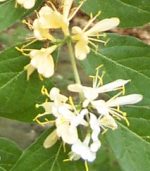 Amur honeysuckle is a deciduous shrub and a member of the honeysuckle family, Caprifoliaceae, that also includes snowberry, weigelia, and abelia. It is native to eastern and central Asia but was introduced into the US and used for hedges and to control erosion but escaped from cultivation and naturalized in the woodlands of the eastern part of the country, spreading to the Midwest. Plants prefer full sun to partial shade and moist soil but tolerate full shade and dry soil, and can be found in deciduous woodlands, woodland edges ,savannahs, and disturbed areas such as roadsides, fence rows and garden edges.
Amur honeysuckle is a deciduous shrub and a member of the honeysuckle family, Caprifoliaceae, that also includes snowberry, weigelia, and abelia. It is native to eastern and central Asia but was introduced into the US and used for hedges and to control erosion but escaped from cultivation and naturalized in the woodlands of the eastern part of the country, spreading to the Midwest. Plants prefer full sun to partial shade and moist soil but tolerate full shade and dry soil, and can be found in deciduous woodlands, woodland edges ,savannahs, and disturbed areas such as roadsides, fence rows and garden edges.
Description: This multi-stemmed shrub is rounded and rapidly grows up to twenty feet tall. The bark is gray to tan and exfoliates in vertical stripes. The tan stems are hollow, and fuzzy when young. The opposite leaves are oval to elliptical with pointed tips, and two to three inches long. They are dark green on top, pale green beneath, and have entire margins and some hairs on the veins and leaf stems. The tubular flowers are produced in pairs in the leaf axils, have two lips and long stamens, and are white fading to pale orange. They are very fragrant and one inch long, and appear from mid-spring to early summer, giving way in the fall to persistent bright red to black berries containing numerous seeds. The berries are attractive to birds and the seeds are spread in their droppings. Plants spread by seeds and rooting stems.
Control: Cut, pull, mow, or hoe seedlings as they appear. Dig out older plants being careful to remove all of the root system ; or cut or mow plants until they stop sprouting.In severe cases apply 3% glyphosate to the foliage, or 50% glyphosate to cut stumps. More than one application may be necessary.